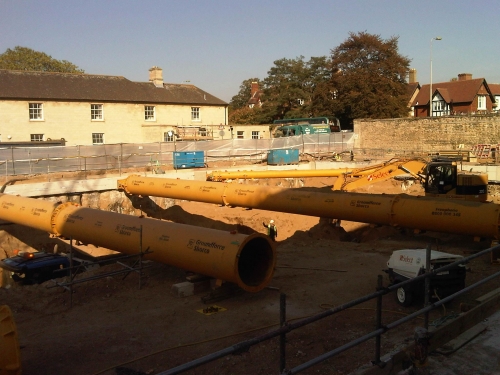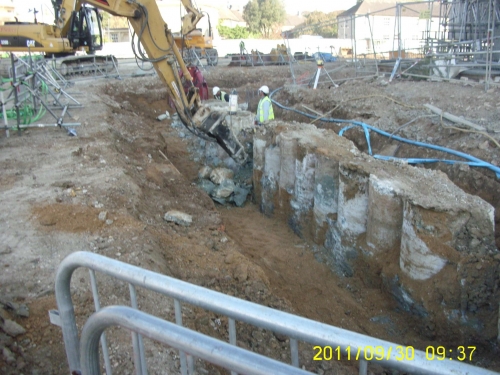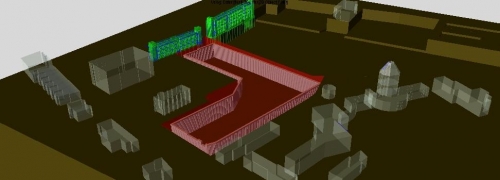New Building Construction: Progress Update 2

Ongoing Works
 Piling Rigs:-The piling activities are now complete and the rigs have been dismantled and transported off site.
Piling Rigs:-The piling activities are now complete and the rigs have been dismantled and transported off site.
Secant Piles:- In total there will have been 532 holes that were drilled, reinforced with steel and concreted to a depth generally in excess of 20m. Secant is a term in mathematics and comes from the Latin secare (to cut). Initially every other hole is drilled and concreted (female piles). These are followed shortly afterwards by drilling into the gaps and the relatively soft female concrete piles, before concreting the male piles. This will form a continuous concrete “wall” underground.
Pile Capping:- The tops of the concrete piles are exposed and are then cut to a more accurate height using a mechanical cropper and breakers. This operation is over half way around the building and will continue for the remainder of October.
Capping Beam:- A concrete capping beam is being constructed along the top of the piles to connect them and form a solid continuous ring beam. This operation has commenced near the Woodstock Road and will continue to the beginning of November.
Steel Propping:- Large steel props are largely installed to one end of the site. These will brace at ground level along the capping beam in order to restrain the ground pressure from the surrounding sides of the building while digging continues.
Gates:- Gate 5 adjacent to the St Lukes Chapel is now operational. Gate 7 remains the main access with Elliot Thomas guard in attendance.
Oxford Site Review:- The monthly department site review for October was carried out last week, showing the progress made to date.
| [bg|new-building/site-visits/20111014] |
Future works for October / November
 The Big Dig:- Excavation of the soil within the footprint of the building has started ahead of programme and is expected to continue until Christmas 2011. There will be over 47,000m3 of soil to be removed. The gravel will be recycled and the clay used locally as fill material. As the excavation proceeds the props and capping beam will be closely monitored to ensure there is no movement.
The Big Dig:- Excavation of the soil within the footprint of the building has started ahead of programme and is expected to continue until Christmas 2011. There will be over 47,000m3 of soil to be removed. The gravel will be recycled and the clay used locally as fill material. As the excavation proceeds the props and capping beam will be closely monitored to ensure there is no movement.
Cleaning of Piles:- Once the excavation of the soil is sufficiently advanced in early November the exposed piles (concrete “wall” below ground level) will be cleaned and inspected.






 Piling Rigs:-The piling activities are now largely installed with drilling operations continuing for only one more week.
Piling Rigs:-The piling activities are now largely installed with drilling operations continuing for only one more week.  Steel Propping:- Large steel props are expected to be secured into position on w/c 10-10-11 using a crane. These will brace at ground level along the capping beam in order to restrain the ground pressure from the surrounding sides of the building once digging commences.
Steel Propping:- Large steel props are expected to be secured into position on w/c 10-10-11 using a crane. These will brace at ground level along the capping beam in order to restrain the ground pressure from the surrounding sides of the building once digging commences.